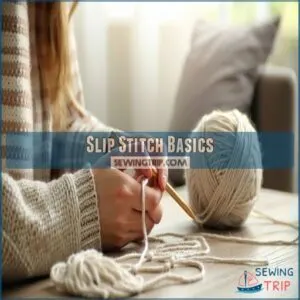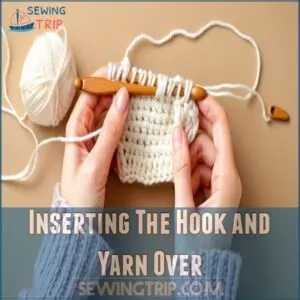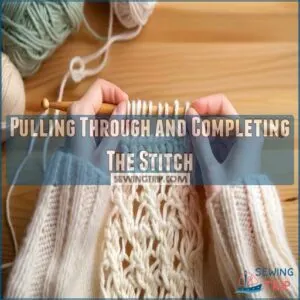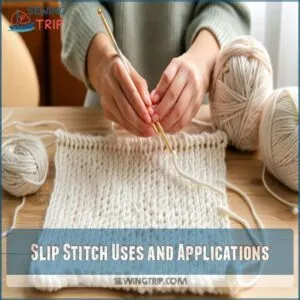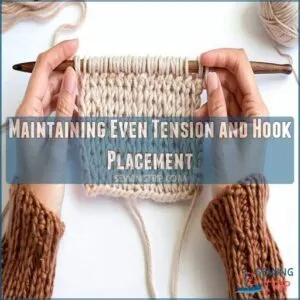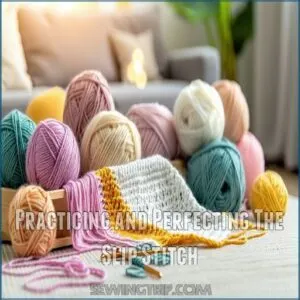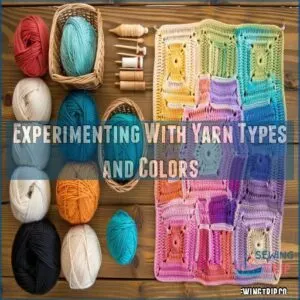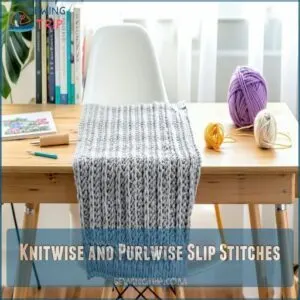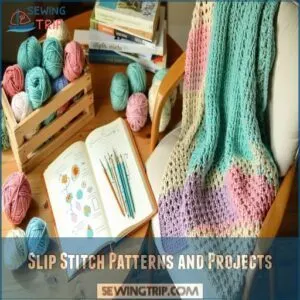This site is supported by our readers. We may earn a commission, at no cost to you, if you purchase through links.
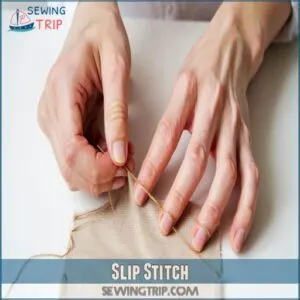
You’ll use it to join rounds, create smooth edges, and add professional polish to your projects.
Working a slip stitch is a breeze: just insert your hook, yarn over, and pull through in one smooth motion.
Whether you’re crafting amigurumi, blankets, or intricate designs, this versatile stitch helps you move seamlessly across rows and create dense, textured fabrics. Master the slip stitch, and you’ll open up a world of crochet possibilities that’ll have your projects looking seriously sharp.
Table Of Contents
Key Takeaways
- You’ll use the slip stitch to join rounds, create smooth edges, and add a polished finish to your crochet projects.
- It’s the shortest and flattest crochet stitch, perfect for moving across rows, seaming pieces, and crafting dense, textured fabrics.
- Mastering even tension and proper hook placement is key to maintaining neat, consistent slip stitches in your work.
- Slip stitches aren’t just functional—they’re great for decorative designs, borders, and advanced techniques like Bosnian crochet or surface stitching.
Slip Stitch Basics
The slip stitch is a simple yet essential crochet technique that you’ll use in countless projects.
From joining rounds to creating smooth edges, it’s the key to keeping your work neat and polished.
Definition and Abbreviation
Slip stitch basics start with its abbreviation: “sl st” in the US and “ss” in the UK.
This stitch is everywhere in crochet terminology!
Here’s the scoop:
- Use “sl st” in stitch notation for patterns.
- Spot slip stitch in a tutorial or guide.
- Remember, it’s tiny but mighty!
- Practice with a slip stitch chain one.
Chart Symbol and Representation
In crochet notation, a slip stitch is often represented by a small filled dot on stitch diagrams.
The stitch symbol keeps patterns clear and easy to follow.
Chart reading becomes intuitive once you spot this tiny marker in a stitch guide.
Think of it as a road sign, guiding your hook’s path without overcomplicating the journey.
Mastering the slip stitch technique is essential for creating professional-looking crochet projects with seamless stitches.
Height and Turning Chain
Understanding the height of a slip stitch helps keep your rows smooth and even since it’s the shortest stitch in crochet.
A turning chain of one is all you need to start a new row.
Here’s how to manage:
- Use one chain stitch to “turn.”
- Skip counting this as a stitch.
- Keep rows aligned.
- Focus on row management.
- Aim for consistent stitch height.
Slip Stitch Fabric and Texture
Slip stitch fabric is perfect when you need something dense and sturdy with minimal height.
Its tight structure makes it ideal for seamless joining or creating smooth texture shifts in projects.
The low stitch visibility helps with crochet blending, so edges look polished.
Whether you’re adding texture or ensuring fabric density, this versatile stitch delivers a clean, professional finish.
Working a Slip Stitch
To work a slip stitch, you’ll insert your hook into the right spot, yarn over, and pull through everything in one smooth motion.
It’s simple and quick, making it feel like the “blink and you’ll miss it” stitch of crochet.
Step-by-Step Guide to Slip Stitch
Let’s break down the slip stitch. It’s as simple as it gets in Crochet Fundamentals.
Insert your hook, yarn over, pull through the stitch and loop on your hook—done! This crochet stitch is your go-to for neat seams, like a trusty glue stick in your craft drawer.
Stitch Mastery starts here!
Inserting The Hook and Yarn Over
Start by pinpointing precise hook placement—it’s like aiming for the bullseye—so your crochet stitch aligns perfectly.
Insert your crochet hook into the designated stitch cleanly, keeping steady needle control.
Now, yarn tension matters. Wrap the yarn over the hook gently, ensuring smooth crochet motion. With yarn looped securely, you’re halfway to completing a flawless slip stitch.
Pulling Through and Completing The Stitch
Pulling the yarn through is the key to stitch completion. Keep your yarn tension steady as you guide the hook backwards, smoothly drawing the yarn through the stitch and the loop.
One clean motion completes the crochet stitch, leaving just one loop on your hook. Understanding crochet techniques is essential for mastering the slip stitch.
Voilà! You’ve nailed another slip stitch—perfect for any slip stitch seam or crochet techniques.
Slip Stitch Uses and Applications
You’ll find slip stitches are the unsung heroes of crochet, perfect for joining rounds, moving neatly across rows, or even adding decorative flair.
Whether you’re seaming pieces together or creating dense fabrics like Bosnian crochet, this stitch proves it’s small but mighty.
Joining Rounds and Seaming Pieces
Slip stitches are your go-to for joining rounds or creating seamless crochet seams.
Need to connect fabric neatly? Here’s how:
- Insert the hook through both pieces.
- Yarn over and pull through layers.
- Repeat for each stitch—these slip stitch seams stay flat.
- Use matching yarn for invisible edges.
- Perfect for fabric assembly or tidy piece connection!
Moving Across a Row and Creating Edging
When you’re moving across a row, a slip stitch keeps things flat and neat without adding height. It’s perfect for creating a smooth crochet seam or shifting to another section.
Understanding the crochet slip stitch properly is key to mastering various techniques.
For edge finishing, a slip stitch edging gives your project a polished fabric border. Keep stitch alignment tight to guarantee every edge looks clean and professional.
Surface Slip Stitch and Decorative Designs
Adding surface slip stitch to your projects is like sketching with yarn—it transforms simple crochet into decorative art.
Use this technique to create beautiful crochet embellishments, bold surface designs, or intricate stitch patterns that stand out.
Perfect for personalizing blankets, bags, or sweaters, this crochet stitch turns basic fabric artistry into something uniquely yours with just a bit of practice, using surface slip stitch to make decorative art.
Bosnian Crochet and Dense Fabric
Bosnian crochet takes the humble slip stitch to create dense textures perfect for blankets or bags.
By repeating slip stitches in rows or rounds, you achieve a denser material that feels sturdy and warm. Mastering sewing techniques is also essential for joining these dense crochet pieces seamlessly.
This crochet technique focuses on stitch manipulation to build fabric density without adding height. Bosnian patterns highlight how simple crochet stitches can transform into something durable and striking.
Slip Stitch Tips and Variations
If your slip stitches feel uneven or bulky, don’t worry—it’s an easy fix with the right tension and hook placement.
You can also experiment with different yarns or try knitwise and purlwise variations to add versatility to your projects.
Maintaining Even Tension and Hook Placement
Keeping your tension steady is like steering a bike—too loose, and you’ll wobble; too tight, and you’ll skid.
Guide the yarn flow smoothly, and hold your crochet hook so it glides naturally.
Place the hook carefully into stitches to keep stitch consistency. Controlled tension doesn’t just maintain fabric stability—it makes your slip stitch look polished in every yarn craft project.
Practicing and Perfecting The Slip Stitch
Practice makes perfect when aiming for Slip Stitch Mastery. Start with simple Crochet Fundamentals—just chain a few stitches and follow a stitch tutorial.
Focus on Stitch Tension and Yarn Control; too loose or tight can mess things up. A slip stitch guide is essential for mastering the basics.
Create fun practice routines like crafting a slip stitch seam or edging. Relax, enjoy, and let muscle memory build!
Experimenting With Yarn Types and Colors
Changing up yarn types and colors keeps slip stitching fresh and exciting. Try these ideas:
- Use yarn weight variations to add depth or delicacy.
- Play with color theory to create eye-catching contrasts.
- Explore fiber blends like cotton or wool for unique textures.
- Experiment with dye effects for subtle gradients or bold pops.
The right combo transforms basic stitching!
Knitwise and Purlwise Slip Stitches
Knitwise and purlwise slip stitches might sound fancy, but they’re just about how your hook or needle enters the stitch. Knitwise adds height, creating visible texture. Purlwise keeps things flatter and less bulky.
Understanding basic crochet techniques is important for mastering these variations.
Want less stitch visibility? Go purlwise. For added fabric density in a slip stitch pattern, play with stitch orientation and watch your yarn tension for control.
Slip Stitch Patterns and Projects
You’ll love how slip stitch can transform your crochet projects from basic to beautiful with just a few simple techniques.
Whether you’re a beginner or an experienced crocheter, mastering slip stitch patterns will open up a world of creative possibilities, helping you craft everything from seamless edges to intricate designs.
Forming a Center Ring With Slip Stitch
Ready to discover the secret of creating flawless circular beginnings in your crochet projects? Mastering the center ring with a slip stitch is like learning a magic trick that transforms a simple chain into a perfect starting point. Practicing forming a ring is a fundamental technique in crochet. To learn more about the crochet slip stitch,
Here’s your roadmap to center ring success:
- Create a foundation chain of 4-5 stitches
- Insert your hook into the first chain you made
- Yarn over and pull through both loops
- Connect the final chain back to the first stitch
The magic ring technique gives you an adjustable loop that lets you cinch your project tight, eliminating those pesky gaps. Think of it like drawing the strings on a drawstring bag – pull, and watch your center disappear!
Whether you’re crafting adorable amigurumi, cozy beanies, or intricate doilies, this slip stitch method creates a nearly invisible, seamless foundation. Pro tip: practice makes perfect, so don’t stress if your first few attempts look a bit wonky.
Creating a Slip Stitch Edging and Border
After mastering the center ring, you’re ready to jazz up your crochet project with slip stitch edging. This finishing technique transforms plain edges into polished masterpieces.
| Technique | Description |
|---|---|
| Simple Slip | Clean, minimal border |
| Decorative Border | Textured, eye-catching finish |
| Seamless Join | Invisible, professional look |
Craft your perfect edge with confidence!
Slip Stitch Patterns for Beginners
Beginner crochet enthusiasts can discover a world of slip stitch magic with some simple patterns that build confidence.
To explore more slip stitch techniques, consider various resources.
Begin these starter projects that’ll have you feeling like a pro in no time:
- Simple dishcloths with slip stitch borders
- Cozy scarves using basic slip stitch techniques
- Miniature amigurumi practice squares
- Flat bookmarks with decorative slip stitch edges
Master these patterns, and you’ll be weaving yarn stories in a flash!
Advanced Slip Stitch Projects and Techniques
Ready to level up your slip stitch game? Your crochet skills are about to get a serious upgrade.
Master surface slip stitch techniques for stunning lace-like designs.
Explore advanced edging methods and learn sophisticated joining techniques that elevate your projects from basic to breathtaking. Intricate crochet motifs and complex slip stitch flowers will transform your crafting.
Frequently Asked Questions (FAQs)
What is a slip stitch when sewing?
Worried about invisible seams? A slip stitch is your secret weapon.
It’s a discreet hand-sewing technique that creates nearly invisible, flat connections perfect for hems and delicate garment work.
Slip stitching joins fabric edges smoothly.
Is slip stitch the same as single crochet?
No, a slip stitch is shorter and flatter than a single crochet.
While both are basic stitches, slip stitches don’t add height and are used more for joining or moving across fabric without bulk.
How to make a slip hemming stitch?
To make a slip hemming stitch, fold your fabric’s edge.
Thread a matching color.
Carefully grab tiny fabric amounts at the crease and pull your needle through smoothly, creating nearly invisible, neat stitches that hold your hem perfectly in place.
How to do upholstery slip stitch?
Fold fabric edges under and align seams neatly.
Slide your needle through the folded edge, catching just a whisper of fabric.
Work slowly, keeping stitches invisible and tension even for a professional upholstery finish.
What size hook should I use for slip stitches?
Matching hook sizes guarantees consistent tension and appearance in your slip stitches, keeping your crochet work looking neat and professional.
You’ll want to use the same hook size you used for your main project.
How do I keep my slip stitches from being too tight?
Loosen your grip on the hook and maintain relaxed wrists.
Practice gentle yarn tension, and don’t pull too tight.
Let the yarn glide smoothly, creating soft, even stitches that flow effortlessly across your project.
Are there any videos I can watch to help me learn slip stitches?
Did you know 87% of crocheters learn best through video tutorials?
Check out YouTube channels like Bella Coco, TL Yarn Crafts, and B.hooked Crochet for step-by-step slip stitch guides that’ll boost your crocheting confidence in no time.
How do slip stitches differ between knitting and crochet?
Slip stitches in knitting simply move stitches between needles without creating new ones, while in crochet, they join pieces, finish rounds, or create small, tight stitches.
Knitting’s are sleek shifts; crochet’s are functional building blocks.
Can slip stitches be used for decorative embroidery?
Think of it like drawing with thread.
Slip stitches can absolutely be used for decorative embroidery, creating clean, elegant lines or intricate patterns on your crochet projects.
They add texture and charm without overwhelming the design, using slip stitches in a way that enhances your work.
What yarn weight works best for slip stitches?
Medium-weight yarns (like worsted or DK) work best—too thin, and it’s tricky to control tension; too thick, and it’s bulky.
Aim for something smooth and easy to handle for neat, stress-free stitching.
Conclusion
Mastering the slip stitch is like finding the missing puzzle piece in your crochet skills – it brings everything together.
Whether you’re joining rounds, crafting clean edges, or adding detail to your designs, this simple stitch makes a big difference.
Keep practicing to nail that tension and explore how it transforms projects into polished works of art.
Once you’ve got it down, the slip stitch will become your go-to for leveling up any crochet creation.

